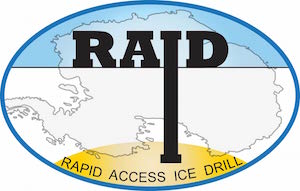
Schematic diagram showing major section of the RAID drilling system. Note, not to scale and shortened by break in the borehole section.
The RAID design is based fundamentally on a conventional diamond drilling system like that used in mineral exploration, modified to operate in polar conditions, operate in an autonomous manner, and reach the depths required by the scientific objectives. A key innovation in the current design is the adoption of a flooded reverse-circulation drilling mode, which has the dual function of maintaining appropriate fluid pressure in the borehole in order to prevent ice borehole collapse, and moving ice cuttings quickly and efficiently to the surface through the inner drill-pipe opening during creation of the deep borehole. The system takes advantage of using “off-the-shelf” components to the degree possible, using time-tested and field-deployable equipment, maintaining a light footprint, and controlling costs to the extent possible.
Other drilling systems were considered, including hot-water, coiled-tube, and wireline electromechanical drills. Although each provides some advantages, they were all discarded in the design process due a combination of high energy use, large fuel requirements, inability for use in rock coring, bulky design, susceptibility to embrittlement and fatigue, inability for field repair, slow cutting rates, and limits to length of core.
Details of the RAID drilling system are outlined by Goodge & Severinghaus (J. of Glaciology, 2016) [see publications]. Principal design elements include, from top to bottom: (1) a diamond drilling rig, modified with electric-over-hydraulic power to fit on a sled-based ISO-type rack/container with a hoistable shroud; (2) a pipe rack, for storage and delivery of auger flights, casing pipe, and drill rods to the rig; (3) diesel power generators installed in a sled-based ISO container; (4) a mechanical shop/inventory container; (5) a custom-designed fluid recirculation system, outfitted within a sled-based ISO container; (6) metal-pipe casing and an inflatable packer unit to make a fluid-tight connection through porous firn between the drill rig and impermeable glacial ice below; and (7) a wireline-deployable bottom-hole diamond drilling and coring assembly capable of retrieving ice, sediment and rock cores.
In concert with the drilling system, an optical dust logger has been developed for wireline deployment in RAID boreholes, based on an earlier design by Bay and others (2001, Geophysical Research Letters). A dust logger is a device designed to measure ice properties by shining a laser light into the ice surrounding a borehole and detecting the backscattered light signal. Dust loggers are used extensively in Antarctica and Greenland for obtaining records of volcanic ash and continental mineral dust in order to rapidly date ice and determine englacial stratigraphy. A new slim version of the Bay-type dust logger was developed specifically for use in RAID boreholes.
RAID is both new and experimental, requiring that the entire system be designed from the ground up. Although such a system to allow for deep, rapid access through the ice sheets of Antarctica has not been built before, the overall design borrows on existing technologies and successful operation of other drilling systems in Antarctica and Greenland. A series of shop and field tests of individual components and the complete integrated rig have validated the principal design.
